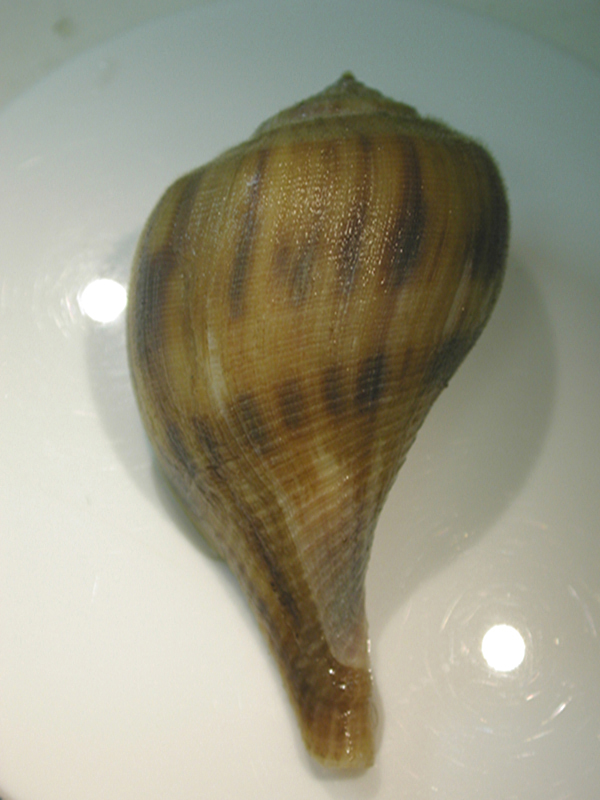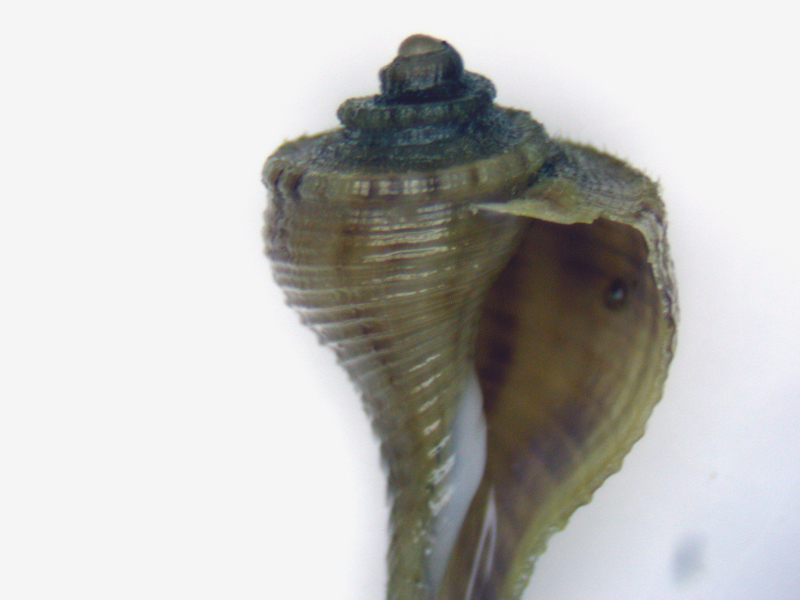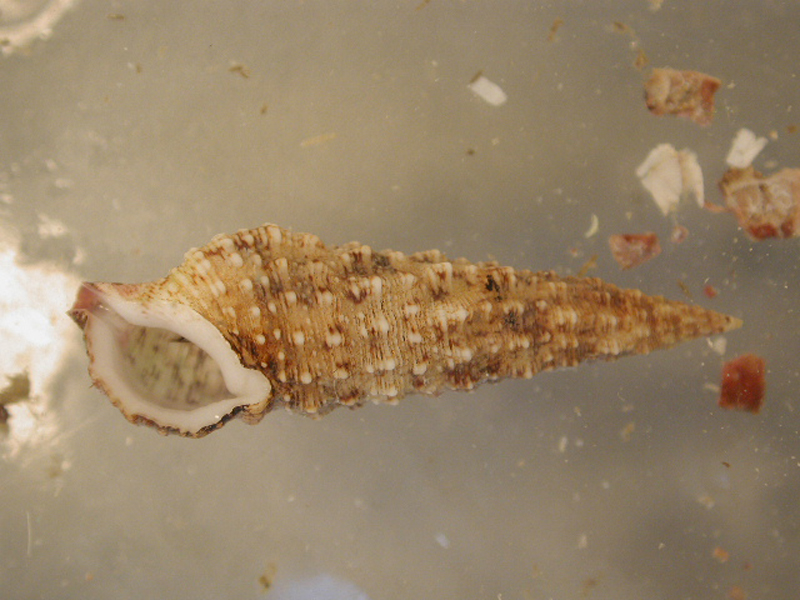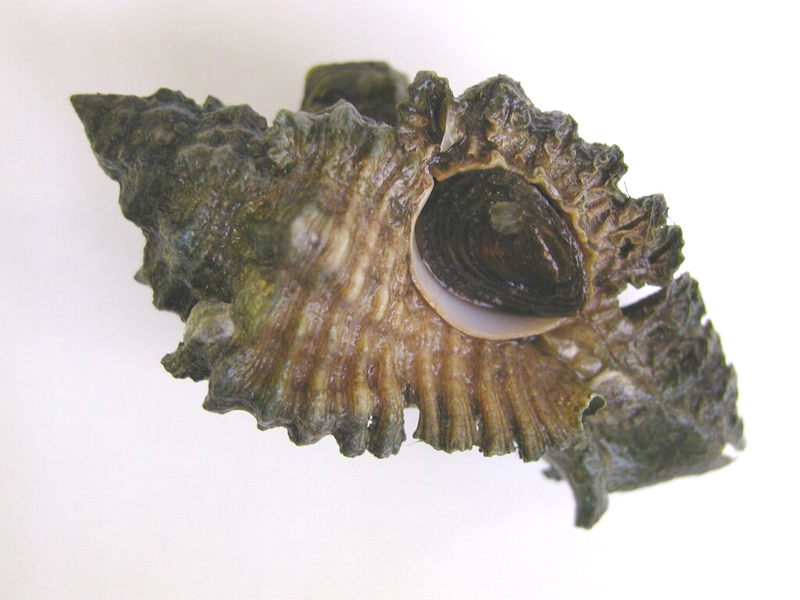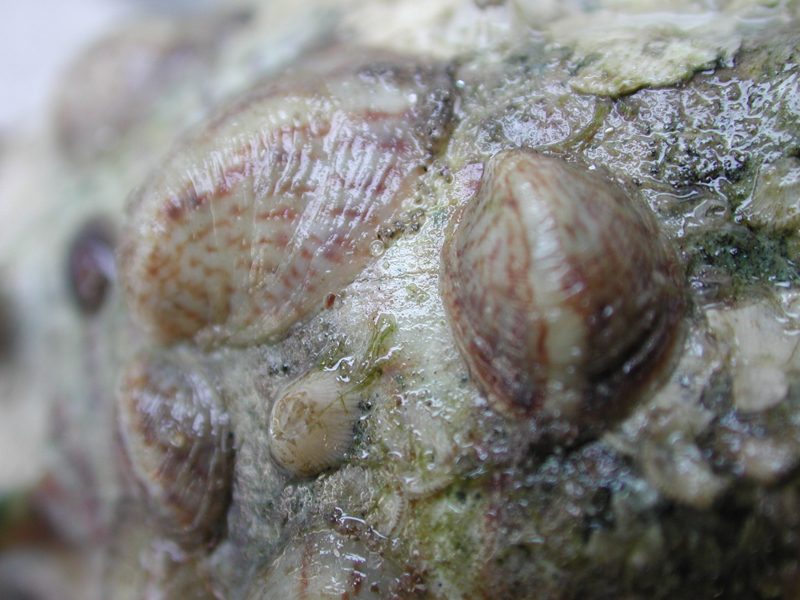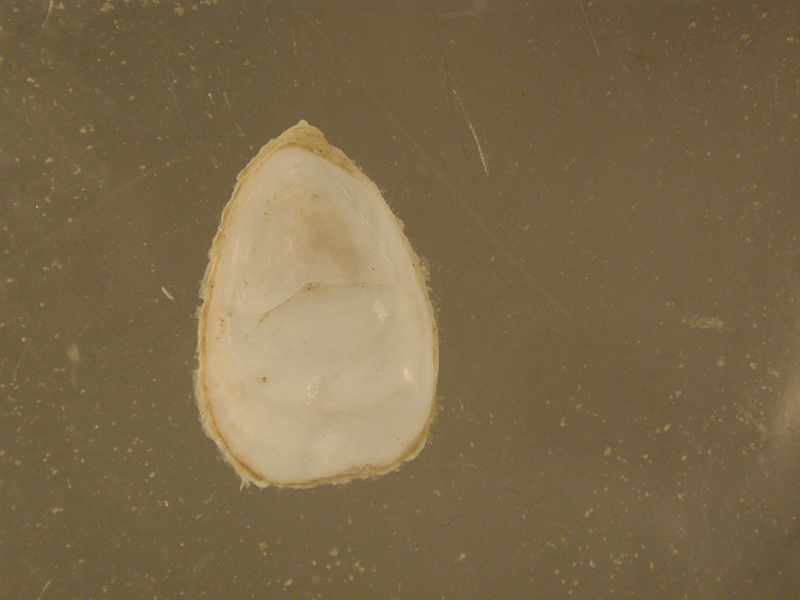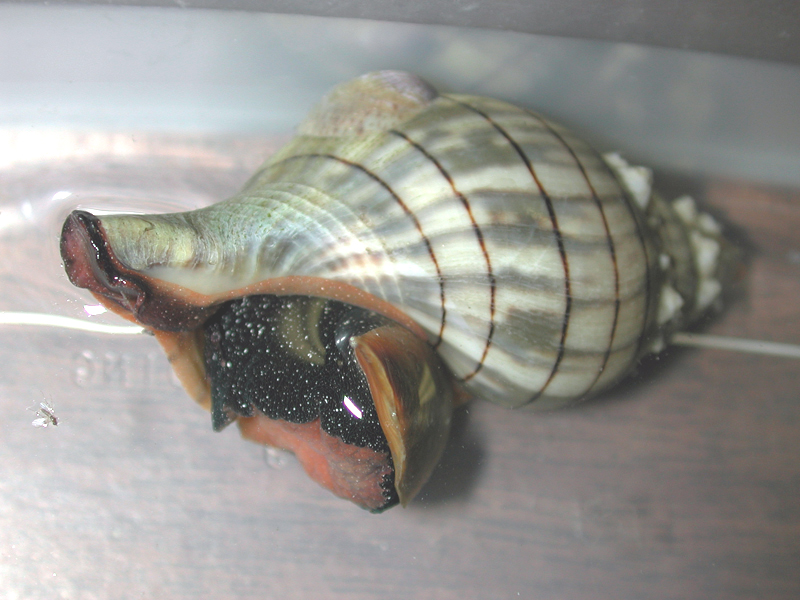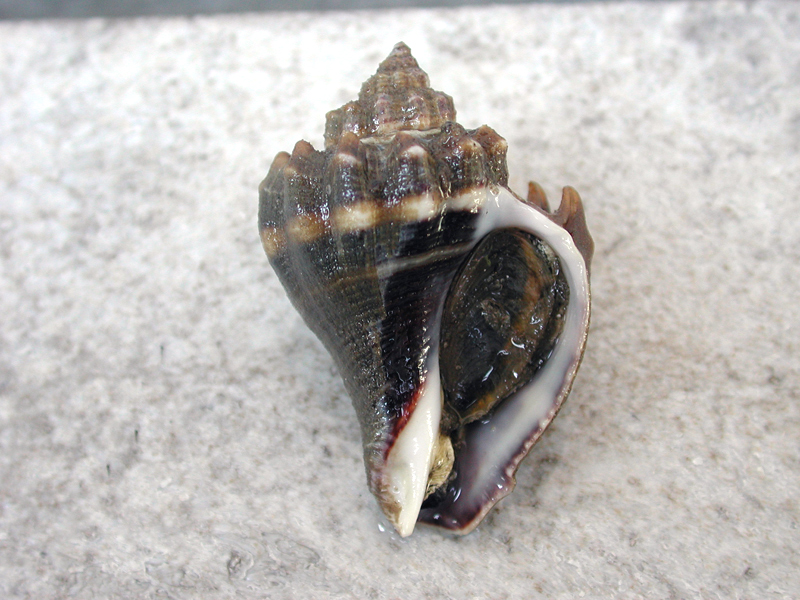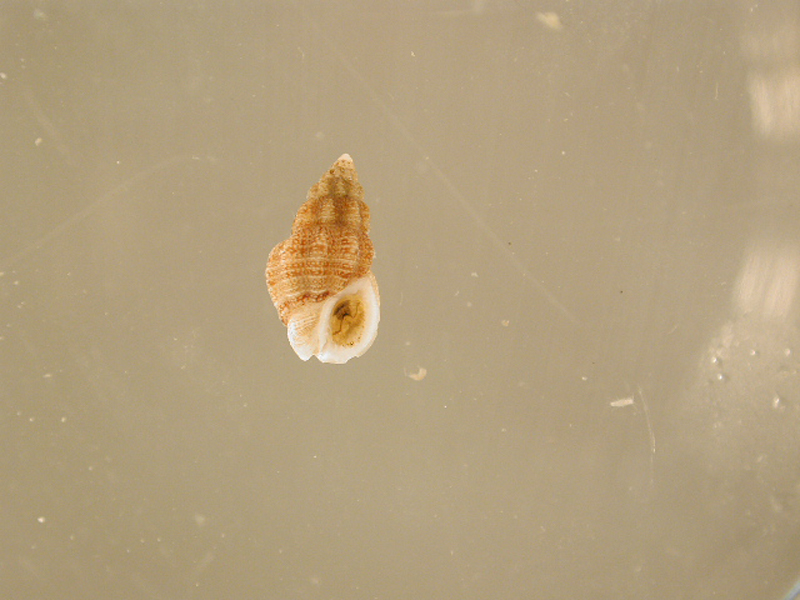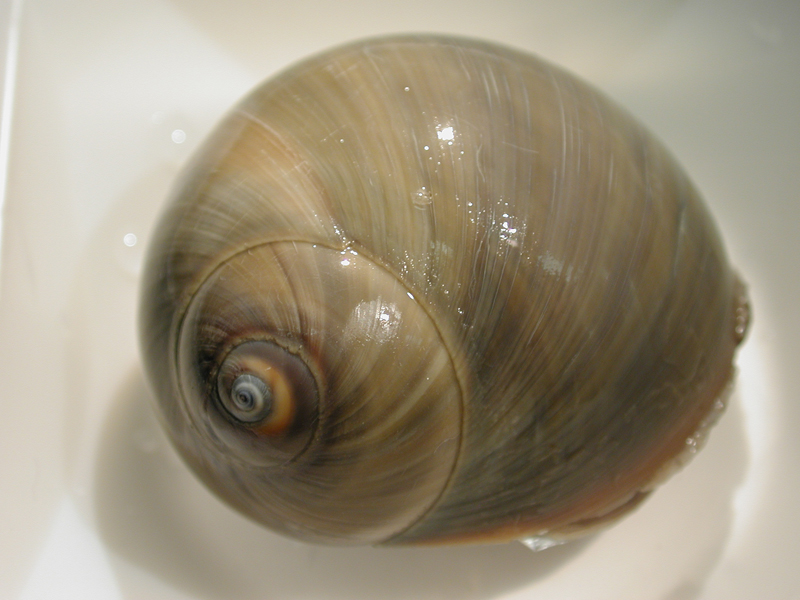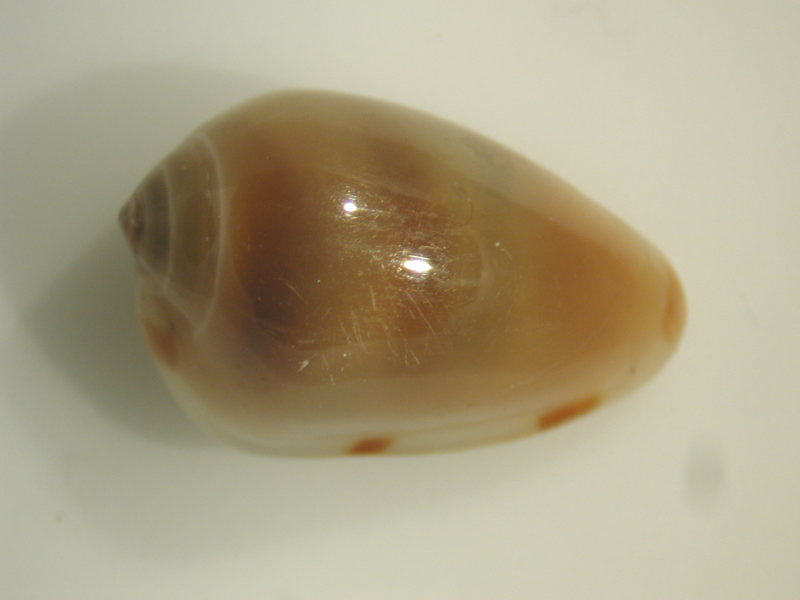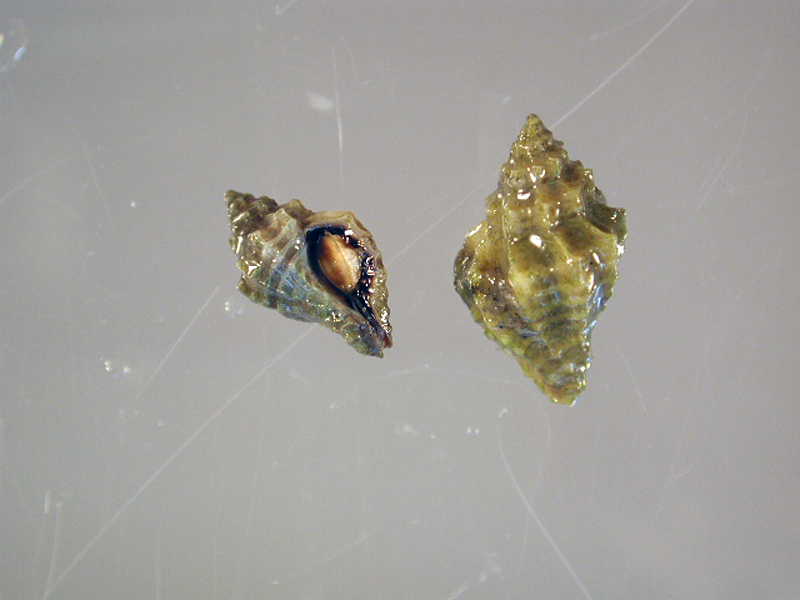Snail-like
Lunar Dovesnail, Black Snail
Description
The lunar dovesnail is a very common snail, often overlooked due to its size; it never exceeds ½ inch in length. It is commonly found in intertidal hard bottoms, crawling around on algae, bryozoans ,or other bottom dwelling growths, especially branching bush-like bryozoans. It is spindle-shaped, having a fat middle and thin ends. It has a smooth, un-sculptured, brown shell with dark zigzags or pale spiral bands. The operculum that covers the long and narrow aperture (shell opening) is horny, and is an elongate oval with a curved narrow end.
What Are The Effects On Clams?
The dovesnail is a detritivore, meaning that it feeds on organic wastes. In doing so, it can consume clam feces and pseudofeces, removing these wastes from the clam bag.
- FRIEND
What Can A Clam Farmer Do?
No action needs to be taken by a clam farmer.
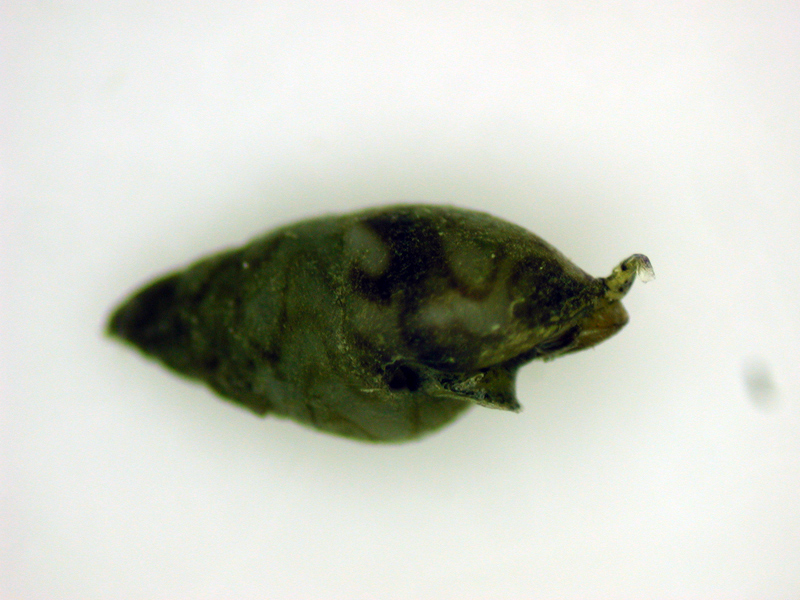
Taxonomy
- Kingdom:Animalia
- Phylum: MOLLUSCA
- SubPhylum:
- Class: Gastropoda
- Order: Neogastropoda
- Family: Columbellidae
- Genus: Astyris
- Species: lunata
Striate Bubble
Description
The striate bubble is a common gastropod (snail) of shallow, grassy mud flats from North Carolina to the West Indies. It has a dome-like shell with a broad aperture and reaches almost 1 inch in length. The shell is white with irregular brown striations, and when the body of the animal is extended, it completely envelops the shell. The bubble snail is a hermaphrodite, meaning that both sexes are contained in one animal, and lays jelly-like ribbons in which its eggs are embedded.
What Are The Effects On Clams?
The bubble snail is a herbivore, meaning that it feeds on plant material. It primarily consumes green macro algae which it grinds up with plates in its gizzard. In doing so, it can help keep clam bags free of macro algae that otherwise may foul the bag.
- FRIEND
What Can A Clam Farmer Do?
No action needs to be taken by a clam farmer.
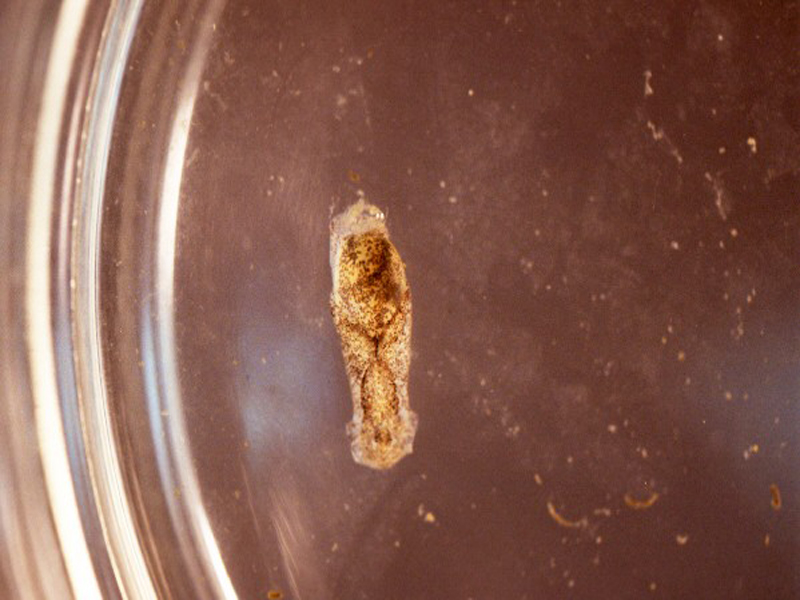
Taxonomy
- Kingdom:Animalia
- Phylum: MOLLUSCA
- SubPhylum:
- Class: Gastropoda
- Order: Cephalaspidea
- Family: Bullidae
- Genus: Bulla
- Species: striata
Lightning Whelk
Description
The lightning whelk is a very large, common predatory gastropod (snail) in Florida's shallow waters. It gets its name from the brown lightning-like streaks down the length of the shell. Older shells tend to be white. This is one of the few "left-handed" snails, meaning the spirals of the shell go to the left. It can reach 16 inches in length and 7 inches in width.
What Are The Effects On Clams?
This whelk feeds on larger clams, by using the hard part of its foot to grasp the clam and hammer away at the edge of the shell until it breaks. Using its foot and body, the whelk rocks the clam back and forth. Gradually the clam is forced open and then it inserts its proboscis (snout) to consume the clam meat. Their predatory activity leaves a distinctive chipped or scrapped mark on the clam shell.
- FOE
- Predator
What Can A Clam Farmer Do?
The clam bag is an effective deterrent as the whelk can not grasp the clam from outside the bag.
Pear Whelk
Description
The pear whelk is not as commonly found as other whelks. It is tan with wavy, reddish-brown vertical streaks. The shell is thin and the body whorl, which has a deep channel, comprises almost all of the shell. The spire is flattened and the shell has no knobs. This whelk can reach a length of 5 ½ inches.
What Are The Effects On Clams?
This whelk is less likely to consume hard clams than the heavier shelled snails, such as the crown conch, and is not found frequently in the clam lease environment. Size preference is for the larger adult clams. Feeding actions are similar to the crown conch; the whelk forces the clam shells open with its shell and then inserts its proboscis (snout) to consume the clam meat.
- FOE
- Predator
What Can A Clam Farmer Do?
The clam bag and cover netting are effective control methods.
Channeled Whelk
Description
The channeled whelk is a very common snail found on sand bottoms in shallow water. There is a deep groove or channel that spirals around the top of the shell. The outer edge (shoulder) of the body whorl is broad and flat, without ornamentation. Color is beige or yellowish gray. There is often a hairy outer layer. Channeled whelks grow to 8 inches long; the opening is about ¾ the total shell length.
What Are The Effects On Clams?
This whelk is less likely to consume hard clams than the heavier shelled snails, such as the crown conch, and is not found frequently in the clam lease environment. Size preference is for the larger adult clams. Feeding actions are similar to the crown conch; the whelk forces the clam shells open with its shell and then inserts its proboscis (snout) to consume the clam meat.
- FOE
- Predator
What Can A Clam Farmer Do?
The clam bag and cover netting are effective control methods.
Dark Cerith
Description
The dark cerith is a tall-spired snail reaching 1½ inches in height, with an oval aperture covered by a dark ovoid operculum (lid-like structure closing the shell opening). It ranges from North Carolina to the tropics, and inhabits shallow, subtidal waters. The dull grey and white-specked shell has 6 or 7 whorls, several longitudinal ribs, and spiral, beaded rows. The edges of its apertures are toothy and thick, with the bottom edge curved outward. Sexes are separate, and eggs are laid in jelly masses or strings.
What Are The Effects On Clams?
The cerith snail is a detritivore, meaning that it feeds on organic wastes. In doing so, it can consume clam feces and pseudofeces, removing these wastes from the clam bag.
- FRIEND
What Can A Clam Farmer Do?
No action needs to be taken by a clam farmer.
Variable Cerith
Description
The variable cerith is similar to the dark cerith, but doesn't grow nearly as big, reaching less than 1 inch in length. It has a sharp spire, 5 or 6 whorls, and revolving rows of beads. It is a brownish color mottled with white, and also feeds upon detritus in the shallow, subtidal waters of the southeastern U.S. The shell is much thinner than that of the dark cerith, and it has a smooth edge to the aperture. The bottom of the aperture doesn't have a hook at the end, as in that of the dark cerith.
What Are The Effects On Clams?
The cerith snail is a detritivore, meaning that it feeds on organic wastes. In doing so, it can consume clam feces and pseudofeces, removing these wastes from the clam bag.
- FRIEND
What Can A Clam Farmer Do?
No action needs to be taken by a clam farmer.
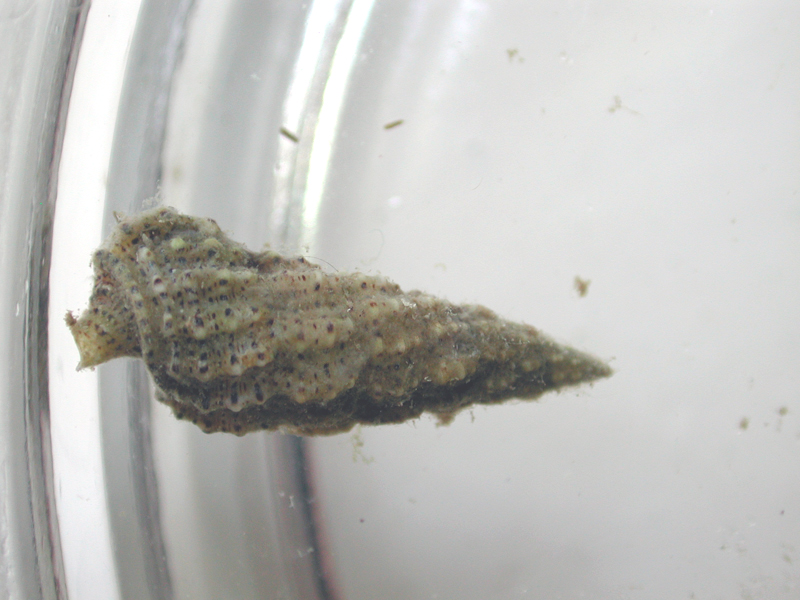
Taxonomy
- Kingdom:Animalia
- Phylum: MOLLUSCA
- SubPhylum:
- Class: Gastropoda
- Order: Neotaenioglossa
- Family: Cerithiidae
- Genus: Cerithium
- Species: lutosum
Lace Murex
Description
The lace murex is found among mangroves, on rocks, mud or sand bottoms, below the low-tide line in shallow water. This snail appears brownish-black to light brown. Younger specimens can be almost entirely pink with the darker pigments developing as the snail grows. The shell is spiny, sturdy, and rough with an elevated conical spire, and has 7 whorls and 3 prominent spiny ridges. The shell opening is small and round with 8 -10 large, leaf-like spines along the outer lip and a stout, circular, blackish operculum (lid to shell opening). The lace murex can reach 3 inches in length and 1½ inches in width.
What Are The Effects On Clams?
This snail is not as commonly found in the clam lease environment as others, but it does prey on clams. Their predatory activities are similar to those of the oyster drill.
- FOE
- Predator
What Can A Clam Farmer Do?
Cover netting over the clam bags can effectively reduce predation by the lace murex.
Common Atlantic Slippersnail
Description
The slippersnails, or slipper shells, are among the most common gastropods (snails) in shallow waters in the southeastern U.S. They get their name due to a shelf on the inside of the shell, making it look like a slip-on shoe. The common Atlantic slipper shell is a convex shell with a downward curve at the front of the shoe and can form large stacks.
What Are The Effects On Clams?
The slipper shell attaches to the shells of clams, possibly hindering the clam from burying. Also the fouling on the clam shell can make them less desirable for marketing.
- FOE
- Fouler
What Can A Clam Farmer Do?
A clam farmer can easily remove slipper shells from the clam shell by popping them off.
Eastern White Slippersnail
Description
The eastern white slippersnail, or slipper shell, is a very common shallow water gastropod (snail), ranging from Nova Scotia to Texas, and found in similar locations as the common Atlantic slipper shell, but is easily differentiated. The white slipper shell is more of a white color, more concave, and flatter than the other. Like the Atlantic slipper shell, it is a herbivore, feeding on macro algae, or seaweeds. It can often be found on the inside of hermit crab shells. This species does not form large stacks. Instead, a small male can be seen atop a large female.
What Are The Effects On Clams?
The slipper shell attaches to the shells of clams, possibly hindering the clam from burying. Also the fouling on the clam shell can make them less desirable for marketing.
- FOE
- Fouler
What Can A Clam Farmer Do?
A clam farmer can easily remove slipper shells from the clam shell by popping them off.
Banded Tulip
Description
The banded tulip is a common shallow water snail found in sandy bottoms, mud flats, and grass flats. It has about 8 smooth whorls, and reaches up to 3 inches in length, having a very distinct, uninterrupted black band encircling the shell. A large, brown, horny operculum, or lid-like structure, completely closes the shell opening when the animal is frightened. The tulip snail is a voracious predator of other mollusks, both bivalves and gastropods. It uses the thick lips of the aperture to break mollusk shells, and insert its proboscis (snout) to feed. Tulips lay clusters of conical egg capsules onto hard substrate.
What Are The Effects On Clams?
The tulip snail commonly preys on other snails, but is an opportunistic predator on clams. Its feeding behavior is similar to that of the crown conch.
- FOE
- Predator
What Can A Clam Farmer Do?
The clam bag is an effective deterrent to the banded tulip snail.
Crown conch
Description
While its name is correct in terms of the description of the shell (crown-like), the crown conch is not a true conch (true conchs are herbivores and have a distinct notch in the edge of the aperture). The shell is like no other, in that it has very distinct white, curved spines on the shoulder of the shell, which has a rather short spire. The shell is usually brown colored with white spiral bands, and the internal column is white. The body is dark colored, usually speckled with white, and has a horny operculum (lid-like structure closing the shell opening). This snail is a common sight in shallow estuarine waters of the Gulf of Mexico, and is usually associated with mangrove forests and oyster beds along mud flats. It feeds on mollusks (oysters and clams) and other gastropods, but will also scavenge for dead animals. Egg cases look like a string of small potato chips. In the same family as the lightning whelk, this snail’s eggs complete larval stages while in the case and resemble tiny adults when released, unlike many other gastropods.
What Are The Effects On Clams?
The crown conch is an active predator of clams and is abundantly found in clam lease areas. The conch opens a clam by placing the lip of its shell between the clam’s shells. Once the shells are forced open, the conch inserts its proboscis (snout) and consumes the clam meat by rasping away the tissue with its radula, which is a file-like apparatus. There is little evidence on the clam shell of this predatory action. As the conch’s proboscis may extend as much as 6” to reach its prey, the conch can easily consume clams from outside the bag.
- FOE
- Predator
What Can A Clam Farmer Do?
The bag does not deter this conch, but cover netting (chicken wire or plastic) may effectively limit the conch’s access to the bag. Large numbers of crown conchs can be found at times on the lease area. Although removal by hand may be impractical, a clam farmer may try controlling by trapping. Traps are simple small cages made of chicken wire with clams or fish used as bait. There are no state regulations pertaining to the harvest of crown conch, so removal of this snail from the lease area is permissible.
Bruised Nassa, Dog Whelk, Mud Snail
Description
The bruised nassa is the most common of the dog whelks in the southeastern U.S., found on sandy intertidal zones from the Gulf of Mexico to North Carolina. The conical shell is grey to greenish-grey, and has distinct beaded ribs along the whorls. The aperture is oval with pale, flaring lips. The outer lip is toothed along the inner margin, and the operculum (lid-like structure closing the shell opening) is toothed as well. The animal itself has two distinct antennae-like fleshy projections on the back of its foot. This dog whelk feeds upon the eggs of polychaete worms as well as detritus and dead animal material.
What Are The Effects On Clams?
The dog whelk is one of the most common snails found on a clam lease. It is a detritivore, meaning that it feeds on organic wastes. In doing so, it can consume clam feces and pseudofeces, removing these wastes from the clam bag.
- FRIEND
What Can A Clam Farmer Do?
No action needs to be taken by a clam farmer.
Moon Snail, Shark Eye
Description
The moon snail is a common predatory gastropod along the Gulf of Mexico and Atlantic coasts, the shell reaching 3 inches in length. So called due to the blue at the center of the spherical shell apex, the moon snail is found along intertidal sand flats. The animal, when extended, nearly covers its glossy shell, and produces protective mucus to easily slide through the coarse, abrasive sand. They are predators of other mollusks, using their foot to dig up bivalves. Their calling card can be seen among many dead shells washed up on the beach — a perfectly round, beveled hole near the umbo (pointed portion, or “beak,” of a bivalve shell) produced by the moon snail's file-like radula to reach the soft animal inside. Another common sight around shallow sand flats is the moon snail's egg case, the sand collar, which is a 3-4 inch case that looks like a wide, inverted funnel made of sand grains
What Are The Effects On Clams?
The moon snail is found frequently buried in nursery and growout bags, entering the mesh openings as small juvenile snails and growing with the clams. This snail attacks clams in the bag by holding them in place with a large muscular foot. It gains access to the clam shell by means of a flexible proboscis (snout), which extends well beyond its mouth. Attached to the proboscis is a radula, which looks like a file, and an accessory boring organ resembling a soft pad. When the pad is applied to the clam shell, secretions soften the shell to allow the radula to scrape out a hole in the shell. Once the shell is penetrated, the clam meat is consumed. A beveled hole, often found near the shell hinge, is evidence of moon snail predation.
- FOE
- Predator
What Can A Clam Farmer Do?
Since moon snails are burrowers and typically found inside the bag, control is limited. Removal of large adults and their egg cases, which look like a sand collar, by hand or by trapping may reduce snail numbers on the lease.
Common Atlantic Marginella
Description
The common Atlantic marginella occurs abundantly in grass beds at the low-tide line and below in shallow water. This plump little snail can be cream-colored, yellowish, golden, or orange-brown, and has four reddish spots on the outer lip. The shell has a short spire and 3-4 whorls with a large, convex body whorl. The shell opening is long and narrow with a smooth outer lip and an inner lip with four strong folds. There is no operculum (lid that closes the body opening) present in this species. It reaches a length of ½ inch and width of ¼ inch.
What Are The Effects On Clams?
The marginella snail is a detritivore, meaning that it feeds on organic wastes. In doing so, it can consume clam feces and pseudofeces, removing these wastes from the clam bag.
- FRIEND
What Can A Clam Farmer Do?
No action needs to be taken by a clam farmer.
Oyster Drill
Description
Oyster drills are found on rocks and shellfish beds where they prey on bivalves and barnacles. They use a combination of mechanical and chemical methods to drill a hole in their prey’s shell. The gray shells of these snails have spiraling ridges, as well as distinct ribs that run lengthwise from the top to the bottom. The lips of the opening are thin and sharp, and there is a distinct canal where the siphon comes out. The bottom of the shell is pointed. Oyster drills reach 1¼ inches in length.
What Are The Effects On Clams?
Oyster drills are commonly found snails. They are active predators on oysters, but much less so on clams. These snails are known as drills for their ability to bore through mollusk shells using its radula (a file-like apparatus). Once a hole is drilled, the snail inserts its proboscis (snout) to feed on the clam meat. A straight hole is evidence of drill predation and can be found anywhere on the clam shell. Although its feeding activities are similar to the moon snail, it does not bury and can easily pass through the mesh of a growout bag.
- FOE
- Predator
What Can A Clam Farmer Do?
Clams buried in the bags will not be affected by this snail.

